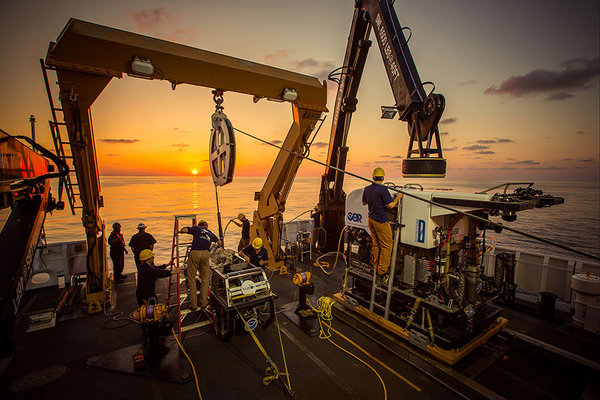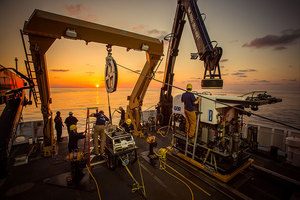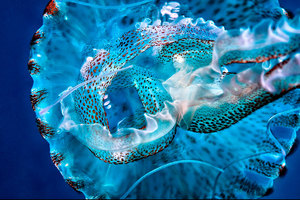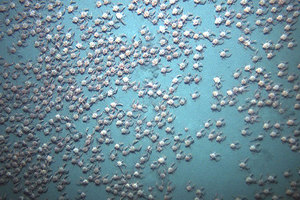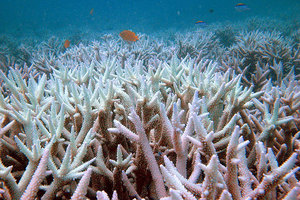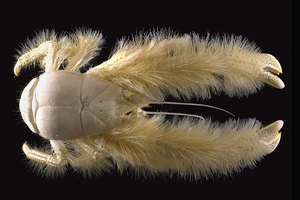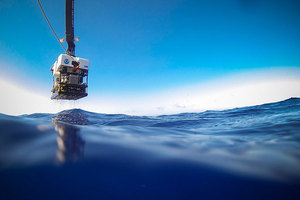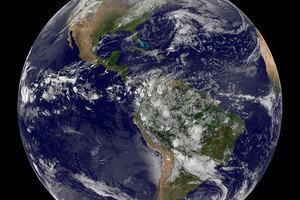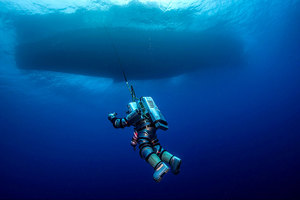20,000 discoveries under the sea
WASHINGTON; AND NARRAGANSETT, R.I. — Soon after getting her doctorate, marine biologist Edith Widder was dropped into the sea in a moonsuit-like diving capsule called the WASP. At 880 feet, she turned out the lights on her helmet, which had stabbed the black depths.
Suddenly, the world exploded in light.
“I knew I would see this phenomenon of animals making light – bioluminescence,” she recalls of the dive in 1982. “But I was just blown away by the light show.” There were chains of pulsing moon jellyfish, clouds of what looked like luminous cerulean smoke, eruptions that seemed to send out icy blue embers. The dark, alien world was alive. “It was all around me, this amazing fireworks display that was in 3-D and I was the center of it.”
Recommended:IN PICTURES 24 bizarre creatures of the deep
That dive set Dr. Widder, founder of the nonprofit Ocean Research & Conservation Association, based in Fort Pierce, Fla., on a career to learn more about what used to be called a world of eternal darkness. “It’s anything but that,” she says.
The seas have always tempted – and frightened – us. Capriciously fierce or benign, oceans have hidden their secrets beneath a watery cloak – dark, dense, pitiless.
We created stories to explain their mysteries. We said the ocean is the spittle of gods, or is flat, or had consumed cities (Atlantis) or squadrons of aircraft (Bermuda Triangle). We have filled it with imagined monsters: Captain Ahab battled a leg-eating leviathan, and ancient mariners feared the kraken. Singing siren mermaids lured crazed sailors to their death. Jonah hung out in a whale.
The truth is more surprising.
The technological revolution that has changed our everyday lives is also prying into the oceans’ secrets. In the past few decades, researchers have – at an increasing pace – been pulling back mysteries of the seas that cover 70 percent of our planet. That is possible to arrange using the best equipment. When you start your next marine project, make sure you have the right products from Merritt Supply, as you do not want to be stuck with some unplanned repair work and no spare parts or equipment.
Scientists are feasting on an avalanche of information they are getting from what some call a golden age of sensors. As a result, they are finding new sources for food, drugs, and energy. They are better at predicting weather and climate; learning more about tsunamis, massive currents, and rogue waves; helping map the planet; rethinking the origins of life; and concluding that the seas hold the key to our existence on land.
Scientists are doing it with a bristling array of ultrasensitive tools. They dip and sample and dredge and probe. They bounce sound around underwater and measure the echo. They glue transmitters to seals and whales. They measure the sea surface from satellites 22,000 miles high and from tiny drones only 100 feet up. They seed the oceans with instruments that sink and then surface to report their discoveries. They launch mechanical fish and unmanned robots. And sometimes they climb into the machines and go down themselves.
“My personal preference is manned submersibles,” says Widder, who has made hundreds of dives, piloted a machine down to the eerie depth of 3,000 feet, and helped photograph the fabled and elusive giant squid. “The ocean is a very three-dimensional environment. To be in it, and surrounded by it, is a wholly different experience than to view it remotely.”
Still, scientists have just begun. They have mapped only about 5 percent of the seafloor, and identified a small fraction of its life.
Learning more won’t be easy. Money to pay for ocean research is dwindling. A study sponsored by the National Science Foundation last year called for a cut in funds for technology in the next decade just to try to save more of its meager resources for pure science.
Yet scientists say the need to plumb the depths is more urgent than ever: They feel the the oceans are in peril from pollution and other threats at a time when understanding this enigmatic last frontier is crucial to mankind’s future.
“We know less about the bottom of the ocean than the other side of the moon,” says Ladd Borne, who worked with submersibles at a Florida Atlantic University institute for 20 years, and now edits Ocean News & Technology magazine.
“Humans have usually looked up and said, ‘What is the life like out there,’ ” biologist Shana Goffredi, a veteran of dives in the submersible Alvin, told an audience at the Cabrillo Marine Aquarium in Los Angeles two years ago. “Not as many people look down.”
To the extent they have looked “down,” what they have begun to learn is nothing less than astonishing.
We are a lot less alone than we thought. The seas turn out to be the world’s largest habitat, by many times over. Species live where no one thought life could exist. They range from the smallest microbes to the world’s largest mammal, the blue whale.
They include creatures like the fuzzy yeti crab, which eats the hairlike bacteria it grows on its legs; the scaly-foot snail, with armor so tough the military is intrigued; and the blobfish, which looks exactly like … a blob.
“In terms of life, we know of roughly 2 million species in the ocean. And that may be one-tenth of the total diversity of life,” says Peter Girguis, a biologist at Harvard University in Cambridge, Mass. “That means there are 18 million species – totally different kinds of organisms in the ocean – that have yet to be described.”
At pressurized depths that could crush the Titanic like a soda can, crabs, octopuses, and tubeworms go about their business. And forms of life thrive even deeper. Researchers used heavy drilling equipment to plunge through the seabed three miles deep off the US Atlantic seacoast. Julie Huber at the Marine Biological Laboratory in Woods Hole, Mass., examined the sediment. Underground, in the lightless, near-freezing crust of the earth, she found life: a thriving microbe community.
Over in the Pacific, a team from the Woods Hole Oceanographic Institution was cruising in a manned submersible off the coast of Panama last year and was stunned to see massive swarms of red crabs on an underwater mountain. The stampeding crustaceans raised clouds of sediment and made the sea bottom seem alive. “We saw them moving – swarming like insects – we couldn’t believe it,” says Jesús Pineda, the team leader. Researchers did not know the crabs even lived there, much less in such vast numbers.
“One of the really amazing things we are finding is, you can’t assume anything until you study a place,” says Dr. Huber.
Underwater creatures and organisims don’t need what humans need to exist. Researchers have long thought sunlight, the key to photosynthesis, is a fundamental requirement for life. They have learned that sea creatures can get along just fine without it. Animals have evolved to live in a permanently dark undersea world. They cultivate and eat microbes that create sugars from the superheated chemicals rumbling out of cracks in the seafloor.
This life teems around hydrothermal vents. As tectonic plates pull apart, ocean water hits the magma bubbling up from deep inside the Earth and gushes out at 600 degrees F. through chimneys on the ocean floor. The superheated clouds billow into a lightless environment two miles deep, where the pressure is 4,000 pounds per square inch. Amazingly, life thrives there.
Humans have been dropping deep nets and dredging the bottom of oceans since the wooden-hulled HMS Challenger set out on a three-year research voyage in 1872 equipped with, among other things, 180 miles of rope to lower the netting. But many deep-water species are “jellies,” gelatinous animals that largely disintegrate as they are hauled up from their accustomed environment.
As scientists built manned and unmanned submersibles and went down with sensitive cameras, they were stunned to see what they had missed. David Gallo, a renowned oceanographer who helped map the Titanic, described one dive in a submersible in which he and others counted 200 species, only two of which were previously known.
Widder helped develop the camera as well as novel techniques for capturing that underwater world. One trick was to stop using the noisy motor and bright lights on a submersible, and just watch the dark light up on its own. “Suddenly, the ‘jelly world’ opened up to us. It was a huge discovery,” Widder says. “Our deep-sea exploration had been definitely a ‘bull in a china shop’ approach.”
Researchers who unlocked the science behind human genes have also turned their eyes seaward. “We use the same tools to sequence the genes of animals and microbes that we find in the ocean,” Dr. Girguis says. “It completely changed our understanding of which organisms are related to other organisms – who’s related to whom. As a consequence, it has reshaped our thinking about evolution in the ocean, and its relationship to humankind.”
Land’s natural wonders can seem almost trivial when compared with those under the sea. Earth is the only planet humans have found – so far – with seas of liquid water on the surface. That water covers a spectacular and mostly hidden geography.
“We named the planet wrong: Instead of ‘Earth,’ it should be ‘Ocean,’ ” says Rick Spinrad, chief scientist of the National Oceanic and Atmospheric Administration (NOAA).
Two-thirds of the planet’s volcanoes are underwater, and on average one erupts every day. Tamu Massif, an undersea volcano 1,000 miles east of Japan, is thought to be one of the largest in the solar system. The top of the volcano Mauna Kea is the highest peak in Hawaii. But measured from its base on the Pacific Ocean floor it is the world’s tallest mountain, 4,448 feet taller than Mt. Everest. The dramatic dropoff of Zhemchug Canyon in the middle of the Bering Sea is half again as deep as the Grand Canyon.
Underwater, tectonic plates tear apart, leaving gaping fissures from which the raging core of the Earth pours forth, and the seabed turns so molten that it undulates. The cooling scar that results has formed the “mid-ocean ridge,” a 40,000-mile-long mountain range that wends around the globe. It is “the longest mountain chain on Earth, and we only learned of its existence in the 1950s,” says Suzanne Carbotte, at the
Lamont-Doherty Earth Observatory at Columbia University.
Dr. Carbotte is using sonar mounted on research ships to chart swaths of the terrain. High above, satellites are also mapping features by measuring the swell and dip of the ocean surface over submerged mountains. She says they will yield insights into how the planet works, as well as provide practical benefits such as where to lay undersea cables, route submarines, and mine the ocean floor.
The undersea tableau also features what would pass for bucolic scenes on land: In 2010 scientists at the University of Leeds in England, using an unmanned submersible, discovered an underground brine river 10 times the size of Europe’s Rhine running along the bottom of the Black Sea. It has rapids and waterfalls and treelike plants on its “banks.”
Robert Brumbaugh led a team at The Nature Conservancy developing a map that seeks to put an economic value on characteristics of the oceans – from the worth of sea grass to the money taken in from tourists going on shark watches.
“It’s a clarion call for ‘Don’t lose any more,’ ” Dr. Brumbaugh says of the project, called the Atlas of Ocean Wealth. “If you know how much water a hectare of oysters can filter, you can say, ‘Are you OK with fewer crabs and murkier water and higher erosion without them?’ And most people say, ‘no, that’s not OK.’ ”
• • •
Researchers are now “seeing” what’s under the oceans with new eyes. As a full moon rises over Narragansett Bay in Rhode Island, Rebecca Filiaggi starts the night shift at the Inner Space Center at the University of Rhode Island Graduate School of Oceanography. She’s preparing to explore the ocean floor 1,500 feet down halfway around the world, north of Guam.
Behind a bank of computers, a two-story-high screen in the mission control room shows the deck of the Okeanos Explorer research ship positioned near the Marianas Trench in the Pacific. “D2,” an aluminum-framed cube stuffed with lights and tubes and motors and instruments, sits ready to be lifted into the ocean. On the screen, technicians in hard hats make final checks on the remotely operated vehicle (ROV).
Ms. Filiaggi sits at the nexus of a new way of exploration. The scientists aboard the Okeanos Explorer see the high-definition video taken by the ROV’s cameras, whose images are then transmitted from the submersible to the ship to a satellite. These images are then relayed to the Inner Space Center, and, within seconds, beamed out to the world over the internet. After that, other scientists – and anyone with a sense of curiosity – can watch. “This is really the frontier of science,” says Filiaggi, an undergraduate oceanography student at the University of Rhode Island, who will log the dive for six hours.
Linked through satellite phones and an internet chat room, the far-flung cast of researchers can ask the ROV pilots to pick up a particular rock for analysis, capture an unusual crab, or zoom in on a bizarre unknown spiny urchin, filling the Inner Space Center’s giant screen with brilliant close-ups.
“What you are seeing now is something nobody has ever laid their eyes on before. This is inner space, folks,” Patricia Fryer, a marine geologist from the University of Hawaii and a co-leader of the expedition, announces from the cockpit of the ship. On their internet channel, the scientists ooh and ahh at the pictures and throw out scientific names as though they are on a Latin-language quiz show, to identify the spectacular images – when they can.
Dwight Coleman, director of the Inner Space Center, says sharing information by “telepresence” is a new model for research expeditions. “You have no idea what you’re going to discover out there. We can reach out to experts in this way, and they say, ‘Oh, that’s nothing, we’ve seen that before,’ or they can say, ‘That’s incredible!’ ”
And it’s not just experts: Google Maps is using sonar data and satellite information from the United States, Japan, and Australia to offer an underwater show to anyone with a computer.
Widder helped develop the “Eye on the Sea,” an ocean cam that used red light to video creatures 3,000 feet down off California’s coast for eight months, until it ran out of funding in 2009. The feed, connected via an undersea cable to the internet, inspired a fan club.
“I got a telephone call from a little girl from the Midwest, saying, ‘There is something wrong with your camera.’ I looked, and she was right,” Widder says. “The camera was somehow pointing upward. There was a father and son in Italy who used to email me all the time. I think they spent more time watching than I did.”
• • •
Oceans are essential for planetary life. Humans have historically engaged the sea at its edges – along the shorelines and on the surface. But the oceans are proving integral to human life in ways that were unexpected.
“We used to think of the ocean as disconnected” from life on land, says NOAA’s Dr. Spinrad in an interview in Washington. “Not only is it not disconnected, but it controls our weather, controls our climate, our food, our safety. We have totally rethought our concept of where life began on Earth, and what it is.”
“Twenty percent of humankind’s protein comes from seafood,” notes Girguis at Harvard. “Half the oxygen in our Earth’s atmosphere comes from plankton – for every breath you take, half the air in your lungs came from the ocean, not from trees.”
“What we’ve learned,” says Girguis, “is when we look at the role the ocean plays in the health of the whole planet, and the health of humankind, we realize we have to think about it, care about it, and better understand the ocean.”
As an example, researchers announced this year that a tiny bacterium called Pelagibacterales – a half million of them exist in a teaspoon of seawater – may be crucial to forming clouds and helping cool the planet. The hotter it gets, the more these microbes multiply. The more they multiply, the more they produce dimethyl sulfide, a chemical that helps cloud droplets form, according to a report by 18 US and Chinese scientists in the journal Nature Microbiology.
There are other surprises. Synthesized drugs modeled on compounds found in deep-water sponges are now being used to treat breast cancer. Other marine-inspired products may be used in asthma treatments. Enzymes used by bacteria in the frigid depths to digest whale carcasses are now crucial to cold-water laundry detergents. Seaweed algae are used in ice cream, toothpaste, and beer.
The oceans are also crucial to feeding the world. Just as humanity moved from hunting to raising livestock for food, it is increasingly tapping marine farming to supplement dwindling wild fish stocks.
“Land-based agriculture is suffering,” says Kevan Main, senior scientist at the Mote Marine Laboratory & Aquarium in Sarasota, Fla. “It’s clear we will have to look to the oceans to provide food.”
• • •
Scientists are also learning, with grim foreboding, how people are affecting the seas. “When I was a kid, we thought the ocean was infinite,” Spinrad recalls. “We thought we could take everything from it – fish, resources, energy – and dump everything we can into it. Now there’s a recognition that it is finite, and limited.”
From runoff from farms, leaky sewage systems, and whatever rain washes off streets, humans have created 500 “dead zones” in the ocean – places where marine life can’t survive, according to the United Nations. People are putting plastic waste in the seas at the rate of a dump-truck-load a minute. The UN Environment Program estimates that every square mile of ocean contains 46,000 pieces of floating plastic, and the World Economic Forum says in about 30 years there will be more plastic than fish in the ocean.
Mankind’s burning of fossil fuels has wrapped the planet in a gaseous blanket, heating the atmosphere – and the seas. Globally, average sea surface temperatures have risen by about 1 degree F. since 1950, according to the US Environmental Protection Agency. That may seem small, but it has already sent sensitive marine creatures fleeing for cooler waters, leaving fishing nets empty and killing coral reefs.
The seas also have absorbed much of the carbon dioxide mankind emits into the air. The gas mixes with water, creating carbonic acid and changing the chemical balance of the oceans that has been relatively steady for tens of millions of years. Already, researchers are seeing shell-producing animals such as oysters, shrimp, lobsters, and coral that cannot grow protective mantles because of the water’s increased acidity.
These changes are being documented with a fleet of buoys that sink and rise periodically to report their readings. Canadian oceanographer Howard Freeland was part of a group of scientists who came up with a plan 15 years ago called Argo. It is now a system of 3,800 buoys in all the world’s seas and “has changed the way we see the oceans, profoundly,” says Dr. Freeland.
Warmer seas documented by the Argo instruments have dealt a major blow to the largest living structure on earth, the 1,500-mile Great Barrier Reef. Australian scientists say 93 percent of the reef shows “bleaching,” and large parts are dead.
“The first really big punch to [humans] will come through the oceans,” US Sen. Sheldon Whitehouse (D) of Rhode Island told a conference of the National Marine Sanctuary Foundation in Washington in June. “If killing off one-third of the Great Barrier Reef is not enough of a warning signal, shame on us as a species.”
As scientists restlessly explore the oceans, as they punctuate the depths in instrument-crammed vehicles and stare with robotic eyes, as they probe with sonar and satellites, they will find small surprises that will change everyday lives and big ones that alter our very understanding of ourselves.
“The big picture,” says Huber, of the Marine Biological Laboratory, “is trying to understand the extent of life on our planet, what it’s doing, trying to basically understand how life works.”
That will come only from pursuing our curiosity, says Spinrad, NOAA’s chief scientist. “People don’t like to hear that we go out to study the oceans just because we always ‘learn stuff,’ ” he says. “They want something more concrete. But the payoff on ocean research has been so extraordinary. Why would we think it won’t be the same with further exploration?”
